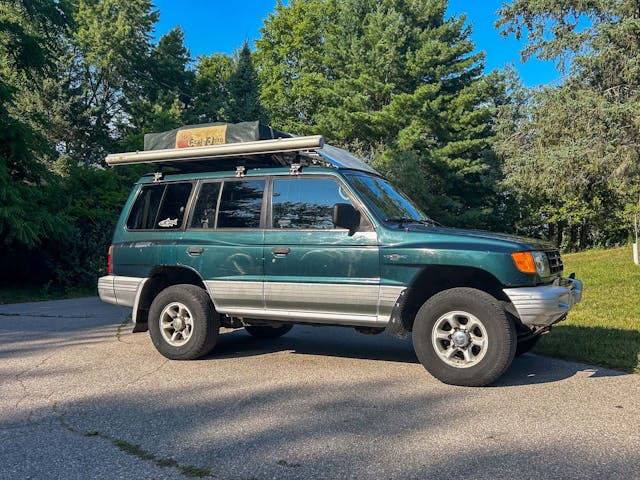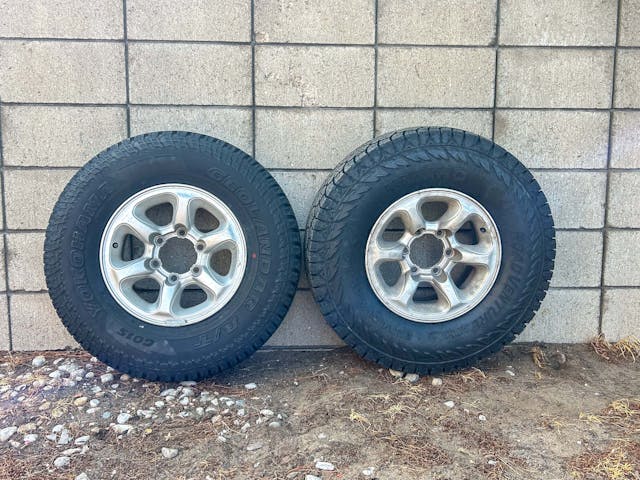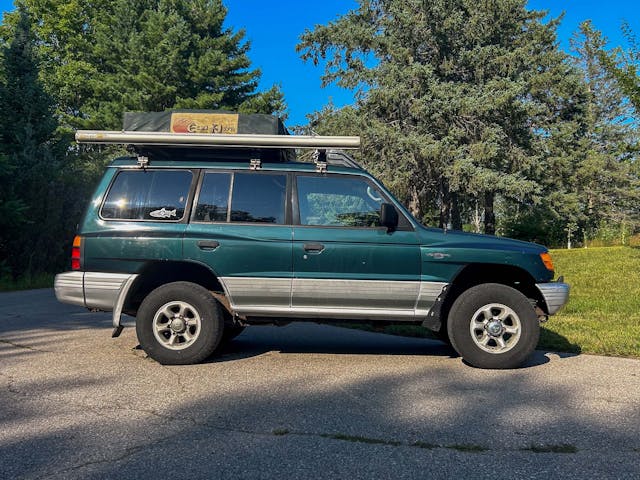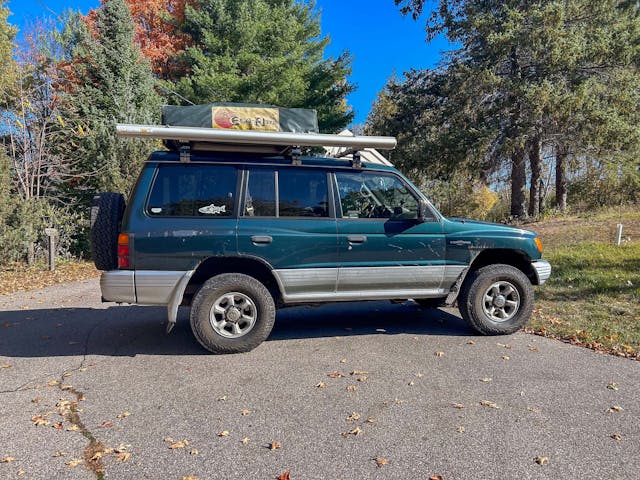What, Really, Are the Costs of Upsizing the Tires on Your Adventure Rig?
Whether for looks, enhanced ground clearance, or some combination of the two, upsizing tires is one of the most popular modifications most folks will make to their off-road vehicle. However, because automobiles consist of multiple systems of intricate parts carefully designed to work in concert with one another to produce specific outcomes, even switching something as seemingly small as tire size comes with consequences.
Poke around online about the topic, and you’ll find any number of opinions ranging from mild to wild about what the actual tradeoffs are for fitting bigger rubber to your rig. To cut through the endless noise about the idea of upsizing—and more specifically, to try to figure out what which noise made sense to consider for my ride—I decided to hunt down those tradeoffs myself.
My 1998 Mitsubishi Montero is delightful, but it’s remarkably slow, somewhat inefficient, and rides like . . . well, a 26-year-old SUV. Put another way: It’s a vehicle that doesn’t have a lot of surplus margin in the areas that would matter, making the potential compromises quite impactful.

In the interest of workbench science, and with the help of resident enabler and fellow editor Kyle Smith, I hatched a plan: Run a series of real-world tests, as closely controlled as I could manage, and gather data across two sets of tires, one smaller, and one larger.
For the smaller tires—the control set, here, really—we have the tires currently on the mighty Montero: Yokohama Geolandar A/Ts, sized 265/70 R15. Switched to Imperial sizing, that’s essentially a 29.5×10.5-inch tire.
In the other corner, we have the Kuhmo RoadVenture AT52, the newest all-terrain tire from Kumho, which first launched in 2022. Finding 31-inch tires for a 15-inch rim proved to be a bit tricky, so when I looked at the sizing charts for these RoadVentures, I was pleased to see that they offered a 31×10.5 R15 option. Kumho graciously mailed me four for this story, and I purchased a fifth one for my spare.

Due to variance in rim sizing and production factors, tires rarely measure the exact sizes that are stated on sidewalls. These 31-inch tires are actually more like 30.5 inches, meaning that there’s just one extra inch of diameter between the old and new tires. If we saw notably different results on the following tests, you can extrapolate out just how noticeable jumping from 29.5s to, say, 33-inch rollers would be.
For the testing regimen, I wanted to gather data around three specific areas: fuel economy, performance, and drivetrain strain. The former two are pretty self-explanatory, but the latter is worth a bit of clarification. When you add larger tires onto a driveline with no other changes, conventional wisdom says that the engine and transmission must work harder to rotate the newer, larger tires. (If you’ve ever tried to climb a hill on a mountain bike with 29-inch wheels vs. the older-style 26-inch wheels, you can attest to how much harder those pedal strokes feel.)
Without further ado, let’s delve into the methodology of these tests and what I discovered, pausing occasionally to review some of the physics at play here.


Fuel Economy
Method: For my fuel economy test, I mapped out a driving loop roughly 80 miles in length up and around Michigan’s Leelanau Peninsula. The route was a mix of stop-and-go driving and longer, more cruise-heavy stretches, mirroring both sides of the driving duties this rig sees. While I’ve spent plenty of time doing interstate speeds, far more is spent at or around 55–60 mph, so I opted for a route that spent a lot of time in that window.
For as much of the route as safely possible, I drove with the cruise control set to 58 mph, as indicated on the speedometer. I used an app on my phone to double-check the speed but noted any discrepancy between the two—which will come into play in a bit.
The route started at the same gas station, where I filled up the Montero‘s tank until the handle clicked off, waited 15 seconds, started the pump again, and waited for it to click off a second time. With a zeroed trip computer, I set off early in the morning to avoid major traffic that might create an unmanageable variable.
The loop finished back at the gas station, where I refilled the tank with the same double-click method, noted the number of gallons pumped, and then divided the trip’s length as measured on Google Maps (79 miles) by the number of gallons to get my fuel economy figure.
Findings:
- Old (Yokohama Geolandar A/T 265/70 R15): 19.5 mpg
- New (Kumho RoadVenture AT52 31×10.5 R15): 16.7 mpg
Analysis: Sure enough, the larger tires were a penalty to fuel economy. In truth, I expected the difference to be smaller, so this was surprising. Several factors likely influenced this difference. The Kumhos have a more aggressive tread pattern to them, with larger sipes and chunkier treadblocks. They look cooler tucked into the Montero’s wheel wells, but they also provide more rolling resistance, which hurts fuel economy.


Performance
Method: With Kyle riding shotgun and the tank completely full, I ripped off a few 0–60 mph acceleration runs with each tire size fitted to the Montero. For both sets of data, the driveline was left in two-wheel-drive, with the electronic overdrive turned off. We picked two days that were almost identical weather-wise to ensure that Mother Nature didn’t play favorites.
I gave it a little brake torque to help it get going and kept my foot flat up until we’d blown past 60 mph. We did three passes with each tire size, averaging the numbers to reach a final figure that was a solid approximation of what to expect.
Findings:
- Old (Yokohama Geolandar A/T 265/70 R15): 13.7 seconds
- New (Kumho RoadVenture AT52 31×10.5 R15): 14.5 seconds
Analysis: Look, nobody is gonna shudder at those times, and I can still count on two hands the number of times I’ve truly floored it in this rig since I bought it. But as expected, the larger tires ate into the acceleration times a bit. I actually expected this gap to be larger, based on what happened with the fuel economy runs. Merging in the Monty has always required extra forethought; looks like it will be more of the same with the Kumhos.


Driveline Strain
Method: While on the fuel economy loop for both tire sizes, I also gathered some data on the following two measurements: 1) How many times the Montero downshifted on a straight but hilly stretch of road to keep cruising at 58 mph with the overdrive on, and 2) What my tachometer was reading at 58 mph with the overdrive on and off. (Measurements were taken on separate stretches of road.)
Findings:
Downshifts on a hilly, straight section of road at 58 mph with overdrive on:
- Old (Yokohama Geolandar A/T 265/70 R15): 2 downshifts
- New (Kumho RoadVenture AT52 31×10.5 R15): 3 downshifts
Tachometer readings at 58 mph, overdrive on:
- Old (Yokohama Geolandar A/T 265/70 R15): 2250 rpm
- New (Kumho RoadVenture AT52 31×10.5 R15): 2475 rpm
Tachometer readings at 58 mph, overdrive off:
- Old (Yokohama Geolandar A/T 265/70 R15): 3000 rpm
- New (Kumho RoadVenture AT52 31×10.5 R15): 3040 rpm
Analysis: Simply put, the engine had to work harder to keep things moving at a near-constant pace, occasionally enlisting the help of the transmission to multiply the power being enacted on the driven wheels. This added strain comes from a few factors that I’ve been waiting to discuss until the end of this piece, because they likely influenced all of the tests here.
First, let’s consider weight. One of the RoadVenture tires weighs 6.4 pounds more than the Geolandars—43.8 vs. 37.4, according to my scale at home. That added heft will require more effort to rotate, penalizing each of the areas we measured above.
The Kumhos are also a larger circumference, requiring just 661 revolutions per mile versus the Yokohama’s 700 revs/mile, per official specs from each tire manufacturer. This added length will strain a driveline more and throw off the speedometer. With the Kumhos, my speedometer indicated 57 mph when the GPS app said I was doing 58 mph. Nothing major, but again, if you’re jumping a few inches up in diameter, you’ll see an even bigger discrepancy.
Although there’s a lot that I’m trading off for the larger tires, there were a few positives that came from the upsize. The Kumhos have a lower load range—2271 pounds per tire vs. 2469 pounds in the Yokohamas—which results in a softer sidewall. That softer sidewall has been a boon for the Montero’s ride, helping it soak up road imperfections and even track a bit straighter. The Kumhos have a lower speed rating as well (112 mph vs. 130 mph for the Yokos), but frankly, If I’m ever nearing triple-digit speeds in this thing, something has gone terribly, terribly wrong.

At the end of the day, I found that, yes, there were penalties to be had for going up in size. However, the severity of said tradeoffs was not enough to make me worry about the long-term effects of these tires on my ride. Add in the fact that the ride got better, the curb appeal improved, and off-road performance is better thanks to increased traction and slightly higher clearance, and I’d say the compromises here are well worth it. I’ve been impressed with the Kumhos thus far and look forward to seeing how they handle a Northern Michigan winter. Perhaps we’ll learn even more when the snow flies!



Excluding a tread penalty, I would tend to expect fuel mileage and RPMs to go down with taller tires, since they are turning fewer revolutions to the same mile
Yeah, good article but that didn’t make sense to me
Fair point, I was a bit surprised by this too. However, I think I was experiencing a little bit of torque converter slip as the engine had to work hard to get the larger, heavier wheels to rotate, hence the increase in RPMs.
Interesting, and the opposite of what I’d expect. I’ve up-sized tires – and wheel/tire diameters too – on a few cars, with different results: slight to appreciable drop in highway RPM, a little better MPG, somewhat slower acceleration 0-60. Those were daily cars, about half stick, half non-OD automatics. On one car – ’73 Dart Slant 6 – the taller combo resulted in earlier locking of rear brakes. That one was probably a bit extreme, going from 205/75R14s to 235/75R15s.
I too wondered about the RPM readings. Larger tire=fewer revolutions per mile/fewer revs per MPH. And given the new tires were an inch taller, that equates to 1/2″ of additional ground clearance, not really enough to (in my opinion) include it as a perk.
You need to correct for speed difference. With the larger tires you were traveling 1 mph faster during your loop which will decrease fuel economy. During your 0-60 sprints (hah!) with the larger diameter tires you were actually timing 0-61 mph.
Sometimes suspension needs modifications because of addional tire weight or stress for larger tires
I’ve seen similar results with my friends trucks when they did similar upgrades. Your Montero looks good, I don’t see many of them anymore.
Thank you, Gary! I really have a soft spot for this thing. It certainly has its flaws, but I believe that any car that tugs on your heartstrings will have something amiss.
I just replaced the 33/12.5/15 BF Goodrich off road tires on my 79 Trailduster with the factory size 235/75R15’s, also BFG. Before this it was a ponderous beast: bouncy ride, handled like a hippo on roller scates, sluggish performance, and weak braking. While not in any way a sports car, now it is transformed into something much more pleasant to drive – on road. The prior owner set it up for off road mudding, hunting, etc. You get what you pay for.
I really don’t think you can do this test accurately with two different brands/models of tires. I’ve noticed changes in mileage and how my truck handles just by switching to another model of tire (from the same manufacturer) that’s the same size.
Nothing terribly surprising to me at this point as I now have modified and operate 3 (well, two are currently running) modified trucks. The “fun” part that comes next are some of the things you can do to mitigate some of the impacts. I’ve regeared the differentials on all of the trucks, two have had their transmissions upgraded, and all three also have added transmission coolers in addition to other cooling mods (radiator, power steering) performed to better manage the strain. I was a bit slow on making these investments on the first truck (currently down and getting a beefed up engine at the moment), but the others are chugging along a bit happier owing to the lessons learned. Happy wheeling!
-fellow enthusiast
Cheers, Will. Within the Montero community, if you go to the next most common tire size (33 inches), the recommendation is overwhelmingly to regear your differentials with the 4.90:1 units out of a Montero sport of similar vintage. That was obviously going to be a costly upgrade, so I stayed shy of upsizing that much this go-around. Perhaps some day we’ll really turn this thing loose, but not until it retires from the daily driver duties.
No test of the impact on the brakes? Stopping that extra rotational inertia is going to take longer.